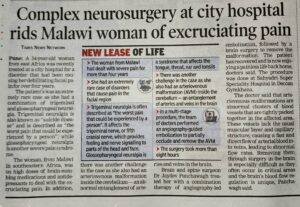Surgical treatment of Trigeminal Neuralgia by MVD surgery is a fairly straightforward one; but if it is complicated by a cerebellar AVM, there are many twists and turns that could potentially be serious.

A rare and technically challenging Brain surgery performed by Dr Jaydev Panchawagh and his team gives a new lease of pain-free life to African woman at Pune.
Arterio-Venous-Malformations (AVM)
AVMs occurring inside the brain are formidable Neurosurgical challenges.
What is an AVM?
An AVM is an area of a densely packed conglomerate of malformed blood vessels. Normally an artery supplying a particular part of brain divides into smaller ‘arterioles’ and then even smaller ‘capillaries’. These smaller vessels have a strong muscular coat in their walls so that they can shrink in diameter to allow the blood flow in brain tissue to be slow and steady for the oxygen delivery to happen effectively.
The used blood is then collected by draining veins which open into bigger venous channels to take it to lungs eventually.
Why is an AVM dangerous?
In an AVM, not only are the vessels malformed, but the muscular layer in the smaller capillaries is absent, making them unable to contract. Also the smaller capillary layer is often absent. This causes direct shunting of arterial blood to the veins at very high speeds and flow rates.
AVMs in the brain are even more formidable as they occur in very important areas and their removal is considered one of the most difficult of brain surgeries…..which are , as a group challenging in the first place.
Secondly, brain being the most prized organ for the body, it’s blood flow follows slightly different rules than the remainder of the body. “Blood brain barrier” and “Cerebral blood flow Autoregulation” are only two examples of its (brain’s) unique nature.
Some of these unique characteristics could also be absent in AVMs, making them difficult to be tamed by surgery.
Another problem with the AVM is a “steal” phenomenon. As the name suggests, due to a very high flow across the AVM and reduced resistance for the flow in this area, some of the blood supply of the surrounding brain is “stolen” by the AVM.
The blood vessels which lead to the AVM, though not directly taking a part in formation of the AVM, increase in diameter, become tortuous and thicken due to continuous higher blood stream flowing through them.
Is AVM dangerous?
Brain AVMs can present with sudden bleeding or fits.
AVMs presenting with compression of the nerves causing neuralgia though known is extremely rare.
Details of this rare case….intolerable Face pain
In the rarest of rare, and surgically challenging case, a 54 year old eastern African patient was treated by combination therapy of Angiography led Embolization followed by Brain surgery to remove the malformation completely.
She was suffering from severe pain in the distribution of Trigeminal nerve and Glossopharyngeal Nerve for last many years.
The pain became intolerable even on very high doses of medicines.
Trigeminal Neuralgia and Glossopharyngeal Neuralgia in same patient
For her double Neuralgia, (Trigeminal Neuralgia and Glossopharyngeal Neuralgia) she came to the MVD surgery Centre at Pune.
But in her case, a simple MVD surgery would not have been sufficient as a more formidable problem in the form of Cerebellar AVM was present in the same area as the nerves.
In fact, the nerves were getting compressed due to high engorged blood vessels supplying the AVM.
Thus it was a much complex problem.
The treatment was planned with a detailed planning sessions with Neurosurgeon Dr Jaydev Panchwagh and interventional vascular specialist Dr Alurkar.
“This was rarest of the rare case, as we had to not only relieve her of extreme pain but while doing it, needed to eliminate the AVM completely.”
Staged operation
In the first stage, AVM was partly occluded by Angiography guided intervention technique.
In this a very thin catheter is inserted in the blood vessels supplying the AVM and medical glue is injected into the vessels.
This glue flows forward a bit and immediately becomes hard, this occluding the AVM blood vessels.
“However, we have to be careful as, if even a small excess amount is injected, it could occlude normal blood vessels or it can flow in normal circulation causing obstruction at undesired sites”
“Also due to tortuosity and curvaceous nature of AVM vessels, some of the vessels may not be approachable for threading the catheter.”
Therefore, after safe embolization, the AVM needs to be removed to ensure instant cessation of bleeding risk.”
“AVM surgery needs skilled operator and has to be done with meticulous planning and with the most modern Neurosurgical equipment.
After embolization, this AVM was still getting blood supply from multiple arteries and was in the cerebellum.
During the surgery, we have to be very careful to separate very important blood vessels which are “passing'” next to the AVM but not supplying it. They are the “transiting vessels” they need to be preserved.
Also, the actual feeding vessels are high flow vessels and need secure clipping before cutting them.
After 8 hour long meticulous surgery, we had to do the most important part.
That was to separate the blood vessels compressing the trigeminal and Glossopharyngeal nerves to treat her pain of Trigeminal and Glossopharyngeal double neuralgia.”
What is MVD surgery?
MVD surgery is a brain surgery during which the affected nerve..in this case the Trigeminal nerve and glossopharyngeal nerve is made free of compression from the offending blood vessel by using a piece of teflon pad. In experienced hands it has low risk.
Dr Jaydev Panchwagh
Dr Jaydev Panchwagh is an eminent neurosurgeon in India. He is based out of Pune. He is the Director of Centre of excellence for MVD surgery, at Pune. He has performed more than 2000 MVD surgeries for Trigeminal neuralgia and glossopharyngeal neuralgia.